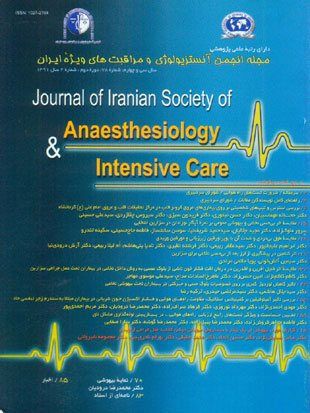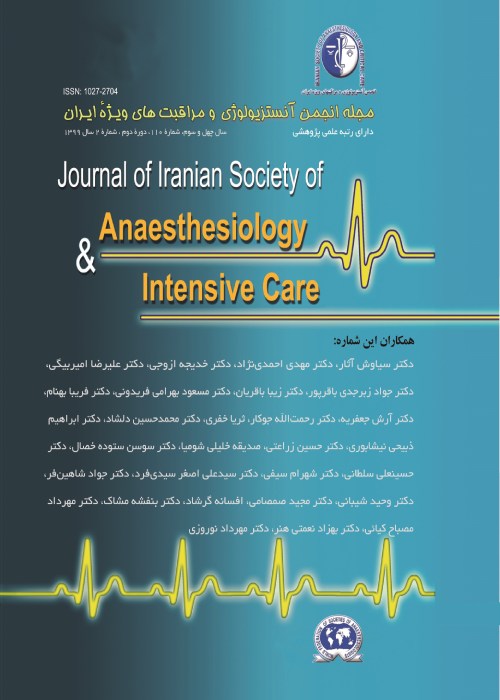فهرست مطالب

فصلنامه آنستزیولوژی و مراقبتهای ویژه ایران
سال سی و چهارم شماره 2 (پیاپی 78، تابستان 1391)
- تاریخ انتشار: 1391/07/15
- تعداد عناوین: 13
-
-
صفحه 70
-
صفحه 83
-
صفحه 85
-
Page 15IntroductionAPGAR score is the most important measurement to evaluate the newborn status. Type of anaesthesia has a definite impact on the Apgar score. Considering the increasing rate of cesarean section in Iran، this study was carried out to compare the effects of spinal anaesthesia and general anaesthesia on Apgar score in neonates delivered by cesarean newborns.Materials And MethodsIn this cross-section study، 172 healthy، full-term pregnant women were selected from elective cesarean section candidates (general anaesthesia group 86 patients and spinal anesthesia group 86 patients) at Imam Ali hospital in Amol city. Each group was assessed for duration time of starting surgery to incision of uterus، and from uterus incision to newborn retrieval. Apgar score at 1 and 5 minutes and demographic variables were determined and compared.ResultsThe average of Apgar score at 1 min was 8. 24±1 in general anaesthesia group and 8. 64±0. 76 in spinal anaesthesia group (p=0. 005). Apgar score at 5 min was 9. 83±0. 55 in general anaesthesia group and 9. 88±0. 32 in spinal anaesthesia group (p= 0. 4). There were no significant differences in variables demographic and duration time of starting surgery to incision of uterus، and from uterus incision to newborn retrieval.ConclusionApgar score of the cesarean newborns at 1 and 5 minutes in spinal anesthesia were more than general anaesthesia. Hence، spinal anaesthesia which is led to newborns with higher Apgar score and less side effects is recommended.Keywords: Spinal Anaesthesia, General anaesthesia, Newborns Apgar Score
-
Page 23IntroductionEffective postoperative pain management is one of the anesthesia goals and there are benefits for rapid recovery and discharge from hospital. The aim of this study was to compare the effect of sublingual buprenorphine versus intravenous morphine on duration and severity of analgesia effects in patients undergoing inguinal herniorrhaphy.Materials And MethodsDuring a single blind clinical trial، 80 patients ASA class 1 candidates for elective inguinal herniorrhaphy under spinal anesthesia were randomly divided into two equal groups. At the start of the surgery، one group was treated with sublingual buprenorphine (tablets 0. 4 mg) and another group was treated with intravenous morphine (0. 1 mg/kg). Patients were observed at multiple hours after surgery to record the time of pain onset and pain severity based on visual analog scale (VAS).ResultsThere was no significant difference between the mean ages of patients (p>0. 05). Comparison of pain onset during the first six hours after surgery and before receiving second dose of these drugs showed a significant difference in increasing the duration of analgesia by the use of sublingual buprenorphine (p=0. 001). The severity of pain during the 24 hours after surgery were lesser in sublingual buprenorphine group than IV morphine (p=0. 001).ConclusionThe result of this study showed that sublingual buprenorphine is more effective than intravenous morphine in controlling pain.Keywords: Analgesia, Sublingual Buprenorphine, Intravenous Morphine
-
Page 37IntroductionSpinal hypotension(SH) is a common side effect of spinal anesthesia and may also occur after the surgical procedure.AimTo determine the comparison of the effect of henylephrine and ephedrine in the treatment of hypotension caused by nerve block in the spinal nesthesia in patient undergoing cesarean section in organ’s educational and medical center Dezyany in2012.Materials And MethodsIn double-blind, clinical rial, 104 patients were undergoing cesarean section ere randomize into two groups: group P (100μg henylephrine) and group E (6μg ephedrine). We ompared the hemodynamic parameters (blood ressure, heart rate) and the incidences of ypotension between the two groups.ResultsThere was no statistically significant difference has been found in treatment of systolic hypotension after delivery between the two groups (p<0.05), but the drug ephedrine was more effective in the treatment of systolic hypotension. There was no statistically significant difference in the treatment of diastolic hypotension after delivery (p>0.05), but the drug phenylephrine was more effective. There was no statistically significant difference has been found in the treatment of mean arterial pressure hypotension after delivery (p<0.05) but the drug ephedrine has been more effective. Discussion andConclusionsInteravenous dose of phenylephrine and ephedrine are effective in preventing hypotension in pregnant women undergoing cesarean section with spinal anesthesia.Keywords: Hypotension, phenylephrine, ephedrine, spinal anesthesia
-
Page 39IntroductionShivering after spinal anesthesia in pregnant women is one of the leading causes of peri-operative stresses. Previous studies have reported a decrease in the incidence of shivering with ketamine administration after general anesthesia. The aim of this study was to evaluate the low-dose ketamine in prevention of shivering after spinal anesthesia for cesarean section.Materials And MethodsIn this randomized and double-blind trial, 90 pregnant women undergoing spinal anesthesia for cesarean section were studied. After spinal anesthesia, patients received either midazolam 0.03 mg/kg plus ketamine 0.5 mg/kg (study group, n=45) or 0.9% saline (placebo group, n=45) intravenously. Incidence and severity of shivering was assessed by using a five-point rating scale (0-4) during peri-operative period.ResultsEight (17.77%) patients of study group had shivering compared to 27(60.0%) of the placebo group (p<0.0001). The number of patients with shivering score of ≥2 were significantly lower in study group compared with placebo group (0 vs 7 respectively; p<0.0001).ConclusionProphylactic use of low-dose ketamine decreases the incidence and severity of shivering after spinal anesthesia for cesarean section.Keywords: Cesarean section, Spinal anesthesia, Post anesthesia shivering, Ketamine
-
Page 43Introduction
The effect of lumbar lordosis on sensory blockade is less studied. Injection of hyperbaric local anesthetics in lower intervertebral spaces can cause pooling of drug in the sacral region. Lumbar lordosis limits drug cephalad spread and sensory blockade so no appropriate sensory blockade level and thus results in intraoperative pain. Determine the effect of decreasing lumbar lordosis by hip flexion on sensory and motor blockade in patients under spinal anesthesia is the goal of this study.
Materials And MethodsIn this clinical trial, after intrathecal injection of hyperbaric bupivacaine 0.5% (3 ml), patients were randomly allocated to one of two positions: hip flexion for 5 minutes then horizontal supine position (case group) and horizontal supine position without hip flexion (control group). Spinal block level was assessed by pinprick and modified Bromage scale. Maximum sensory block level (MSBL), maximum motor block level (MMBL), two segment regression time (2SEGRT), complete motor block return time (CMBRT), MSBL time, MMBL time was determined, recorded and analysed. Finally, data were analysed with T-test, Chi-square and Mann- Whiteny statistical analysis.
ResultsMean of MSBL time, MMBL time, CMBRT was 16.5±4.6 vs 19.5±9.9, 9.1±2.9 vs 10.7±3.4, 125.7±34.2 vs 137.8±36.0 minutes in case and control groups respectively that showed significant difference (p<0.05). MSLB [median (range)] T6(T4-T10), MMBL(3 scores in both groups), mean atrial blood pressure mean, mean heart rate, recovery time and frequency of hypotension and bradycardia incidence showed no significant difference in two groups.Conclusion and
DiscussionDecreasing lumbar lordosis by hip felexion could not change sensory and motor block level. MSBL, MMBL and CMBRT was reduced but 2SEGRT was similar in both groups. Hip flexion decreased the lumbar lordosis but could not prevent sacral drug pooling.
Keywords: Spinal, Anesthesia, Lordosis, Sensory, Motor -
Page 52IntroductionAcute respiratory distress syndrome (ARDS) is one of the most common etiologies of respiratory failure. The aim of this study was to evaluate the effect of Aminophyline on static lung compliance, airway resistance, and arterial oxygen pressure (PaO2) in patients with ARDS.Materials And MethodsIn a clinical trial, 60 cases with ARDS who were under mechanical ventilation in intensive care unit (ICU) were assessed. After sedation and synchronization of patients with ventilators, airway resistance, static lung compliance, and PaO2 were measured. After administration of 5mg/kg aminophyline during 1hour and infusion of 0.5 mg/kg/hour of aminophyline for 24 hours, above mentioned variables were measured again and compared with preinfusion values.ResultsMean airway resistance was significantly reduced after prescription of aminophyline (16.05± 3.55H2O/h/sec vs. 18.96± 3.46 H2O/h/sec, p=0.001). Also, mean static lung compliance (27.44±6.95 ml/cm H2O vs. 24.58±5.65 ml/cm H2O, p=0.001) showed significant increases but mean PaO2 (72.46 ± 10.19 mm Hg vs. 71.5 ± 9.84 mm Hg, p=0.078) did not significantly increases following infusion of aminophyline.ConclusionInfusion of aminophyline in ARDS patients significantly reduces airway resistance and increases static lung compliance without significant increasing of PaO2.Keywords: Aminophyline, acute respiratory distress syndrome, airway resistance, static lung compliance, PaO2
-
Page 59IntroductionAccording to frequency of difficult intubation and contraindictory responses from previous studies about the value of tests to predict difficult intubation, in this study we were evaluated the sensitivity and specificity of four airway evaluation tests included: Malampaty, Thyramental distance, ULBT, and Inter incisicor gap for predicting difficult tracheal intubation.Materials And MethodsIn this study, 448 patients with a mean age of 53/5 years participated. Preoperative assessment of patients to help Malampaty test, thyromental distance measurement, biting the upper lip and inter incisor gap were done. The patients were under general anesthesia by an anesthesiologist. Difficult tracheal intubation according to classification Cor Mack and Lehane was evaluated after induction of anesthesia as the standard test. Data analysis by software to help SPSS16/0, respectively.Results And DiscussionThe incidence of difficult intubation in the study group was 8.4%, the highest sensitivity in detecting cases of difficult intubation was in mallampati test and highest specificity was in thyromental distance and the highest positive and negative predictive values belonged to upper lip bite test. Studies also showed that power of these tests in predicting easy intubation is more than their ability in assessing the likelihood of difficult intubation.Keywords: Sensitivity, Specifisity, Malampaty, Thyromental, Inter incisor gap, Upper Lip Bite Test


